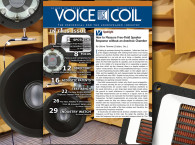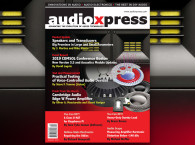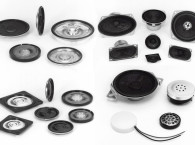
first introduced SoundCheck,
the world’s first widely available
software and sound card-based
audio analyzer, in 1995.
Mike Klasco interviewed Steve Temme, President of Listen, and asked about the important features and how to get the best performance of test and measurement microphones. He also learned about Listen’s recently released measurement microphone power supply.
Mike Klasco: Can I use any microphone as a measurement microphone?
Steve Temme: Not if you want accurate results! There are microphones out there to suit all budgets, but for audio test, it is important to have close to a flat frequency response over a wide frequency range, a low noise floor, and minimal variation in response with directionality. But most of all, you want a really stable microphone that does not change characteristics with temperature, humidity, and age.
If the microphone is stable, you can rely on the calibration curve and sensitivity. If it is not, you need to be calibrating it all the time and you are never quite sure what else is changing. You really want to be buying something specifically sold as a test and measurement microphone rather than a recording microphone.
Measurement microphones are designed to work with measurement-grade calibrators, and since microphone calibration is a critical part of all audio tests, it is important that you use a device that can be accurately calibrated.
Mike: What are the important features in a test and measurement microphone?
Steve: The performance characteristics I just mentioned — a flat frequency response over a wide frequency range, low noise floor, and minimal directionality — are critical. However, for production-line applications, some of the most important additional criteria are not performance related.
Test microphones on production lines are likely to be exposed to extreme temperature and humidity variations, dust, and vibration. In addition, they may encounter rough handling, especially when calibrated regularly.
It is important to select a microphone that will maintain stability and integrity under adverse operating conditions. If the microphone needs to fit a tight space in your test fixture, form factor may also be a consideration.
Mike: What is the difference between a $2,000 microphone and a $200 microphone, and which do I need?
Steve: A decent measurement microphone for audio test applications could cost from around $700 to $2,000. Most microphones will suffice.
The main difference is that the more expensive ones tend to have
a slightly flatter frequency response and are often slightly more precise at high frequencies.

a robust, free-field microphone designed
for the rigorous environment of production
line audio testing without compromising
the accuracy, precision, and stability
required for R&D.
Mike: What hints and tips can you give to help us receive the best performance out of our measurement microphones?
Steve: Calibration, calibration, and more calibration!
A test microphone will be supplied with a frequency calibration curve. It’s important that you import this into your measurement system so it compensates for any variation in the microphone’s frequency response. It’s also important to calibrate your microphone via your measurement system for sensitivity.
This will require the use of a calibrator with appropriate sensitivity for audio test applications, such as Brüel & Kjær’s 4231. Finally, it’s important to recalibrate for sensitivity regularly. Some factories do this daily or at the start of every production run; others do it even more often. It’s also important to add enough gain to your microphone signal to maximize your measurement signal’s dynamic range. There should be a gain adjustment option on your microphone power supply.
Mike: Speaking of microphone power supplies, what are the most important features?
Steve: Just like microphones, power supplies come with a range of features and price points. Obviously, the power supply needs to offer the right type of power for your microphone, whether this is a 10-VDC constant current, integral electronic piezoelectric (IEPE), or 200-V polarization. If you are using a TEDS microphone, you may want a TEDS-compatible power supply that can communicate the TEDS data to your measurement system.
Aside from the functionality, you should also look for something with a wide frequency response and adjustable gain, and low self-noise. Depending on the application and environment, number of channels, ruggedness, form factor, and ease of use may also be considerations.
Mike: I hear you have just launched a new microphone power supply. What makes this product so unique?
Steve: We designed SoundConnect 2 from the ground up to meet every test microphone power supply requirement. It’s truly a universal power supply—in addition to powering our own SCM microphones — it also offers IEPE power for microphones or accelerometers via two microdot connectors on the rear panel and optional 200-V polarization via LEMO connectors. It’s also TEDS-compatible for seamless communication of calibration data to your measurement device. It powers up to two microphones, so it’s useful for stereo testing applications such as headphone testing or applications where you need to power a reference microphone in addition to the measurement microphone. Of course, it meets all the requirements I discussed earlier, including wide frequency response, adjustable gain, and low self noise.
It is also compact, lightweight, and rugged so it is equally useful on the production line or in the laboratory. It can also be fully computer controlled via SoundCheck or a stand-alone application. Such control from within a test sequence further guarantees correct and accurate use on the production line.
What makes it unusual is its price. It’s approximately half the cost of other similar featured supplies on the market.
http://www.listeninc.com/us/products/soundconnect2.html
Originally published by Voice Coil, November 2013

2 mic power supply...







